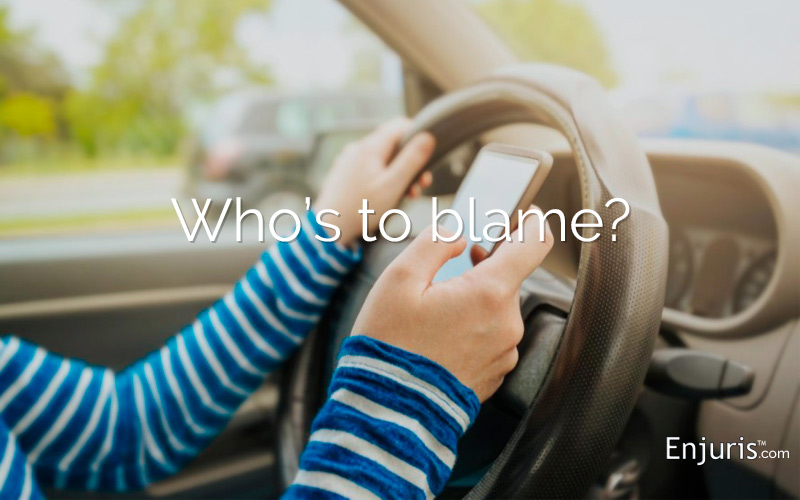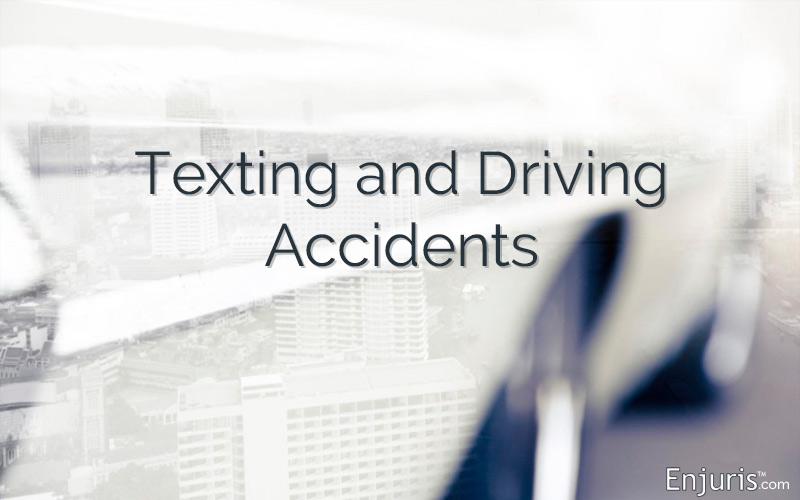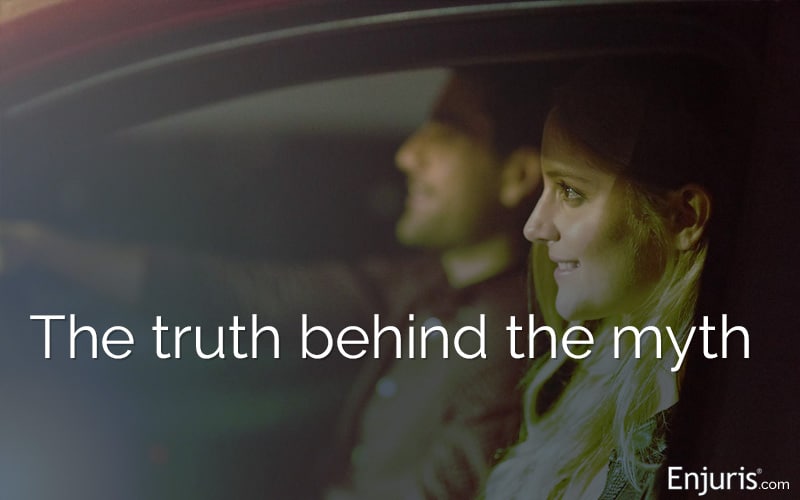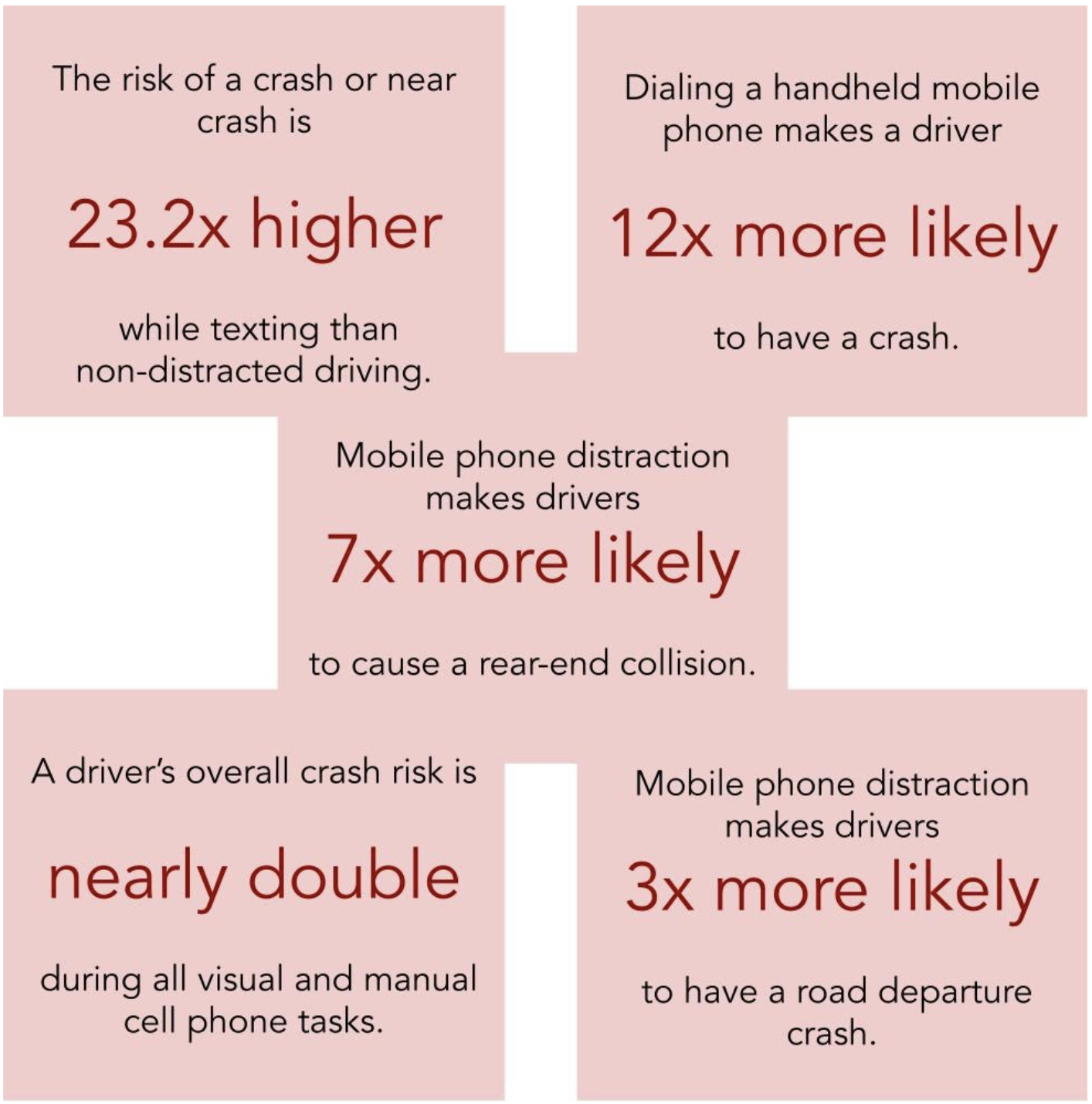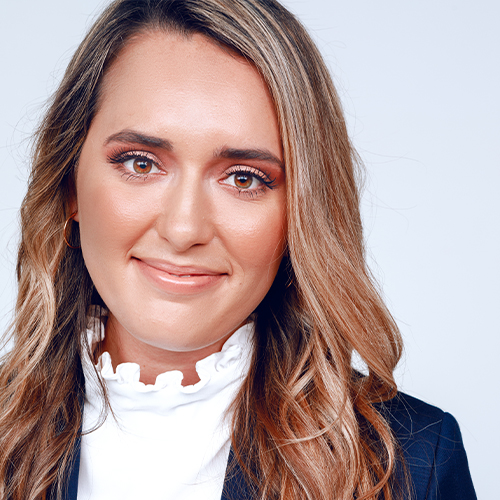
Distracted driving is just as dangerous — if not more — than being a drunk driver. If you shouldn't drink and drive, you shouldn't text and drive, either. What does distracted driving mean to California motorists?
California has one of the lowest distracted driving fatality rates in the country. But this doesn't mean distracted driving isn't a problem in the Golden State. A California Office of Traffic Safety Public Opinion Survey found that 74.3 percent of Californians identified distracted driving as their biggest traffic safety concern.
In this article, we'll take a look at California's distracted driving laws, and we'll explain how the laws might impact your personal injury claim.
What is distracted driving?
Distracted driving is any behavior while driving that takes a person's eyes off the road, hands off the wheel, and mind off the primary task of driving a vehicle.
Now that mobile phones are ubiquitous and nearly every driver has one in their pocket, bag or even cup holder in the car, texting and driving has become a major problem. But distracted driving existed long before mobile phones and it encompasses more than just use of electronic devices.
Types of behaviors that could lead to distracted driving include (but aren't limited to):
- Eating or drinking
- Use of any electronic device, like a phone, tablet, GPS, etc.
- Using dashboard controls like the climate control buttons, radio, etc.
- Applying makeup, hair brushing, shaving, and similar
- Being distracted by children or other passengers in the car
- Distraction from events happening outside the vehicle
Distracted driving can be anything that prevents you from putting your full mental focus and physical capability on the task of driving. However, lawmakers place specific emphasis on texting or mobile phone use while driving because it is proven to be just as dangerous as drinking and driving.
75 students speak out on responsibility for distracted driving
We asked students across the nation whether they thought cell phone manufacturers should be held responsible for distracted driving.
Is texting and driving as dangerous as driving drunk?
Yes, texting and driving is as dangerous as driving drunk.
How do we know?
Car and Driver performed a test to see how drivers' reaction times were impacted by texting and driving, compared to drunk driving. To perform the test, the car was fitted with a light mounted on the windshield that would simulate a car's brake lights. The drivers were instructed to hit the brakes when the light went on. The test took place on an open runway with no obstacles, and the drivers were using typical phones.
Take a look at their findings:
| Test | Driver #1 (age 22) | Driver #2 (age 37) |
| When driving 35 miles per hour | ||
|---|---|---|
| Baseline reaction time | 0.45 seconds | 0.57 seconds |
| Reading a text | 0.57 seconds (extra 21 feet) | 1.44 seconds |
| Writing a text | 0.52 seconds (extra 16 feet) | 1.36 seconds |
| Alcohol-impaired | 0.46 seconds | 0.64 seconds |
| When driving 70 miles per hour | ||
| Baseline reaction time | 0.39 seconds | 0.56 seconds |
| Reading a text | 0.50 seconds (extra 30 feet) | 0.35 seconds (extra 90 feet) |
| Writing a text | 0.48 seconds (extra 31 feet) | 0.68 seconds (extra 319 feet) |
| Alcohol-impaired | 0.50 seconds (extra 15 feet) | 0.60 seconds |
As you can see, the result showed that both drivers were as slow or slower to react when reading or writing a text message than when they were alcohol-impaired.
And yet, although most people understand the danger of drunk driving, they still consider it acceptable to read or write a text while behind the wheel.
Texting & driving laws in US states
Each state is different, and these technologically-based laws are changing every year. Make sure to know the laws in your particular state. This will help you stay safe while driving and avoid getting ticketed.
California distracted driving laws
The intent of the hands-free law is to prevent accidents caused by distracted driving. An activity like dialing, talking, or texting on a mobile phone increases the risk of a crash by three times, according to the California Office of Traffic Safety.
Men more likely than women to die in a distracted driving crash
New data from the National Highway Traffic Safety Administration (NHTSA) and analyzed by international driver's education company Zuboti shows that 75% of the more than 3,000 distracted driving-related fatalities in the U.S. in 2020 were vehicles driven by males.
Of the total distracted driving fatality accidents, only 13% were because the driver was using a mobile phone. The remaining 87% involved other types of distractions, like eating, reading, reaching for objects, or passengers.
Even so, speeding, alcohol, unsafe lane changes, and failure to yield exceed distracted driving as the leading causes of car accidents.
A driver can reach 90 feet in one second when traveling 60 miles per hour. If they're driving 75 miles per hour, they can travel 110 feet during that time.
Most of the tasks included as distracted driving take far longer than one second. That means if a driver is distracted for even five seconds (which is less time than it would take for most people to read or send a text message, for instance), they have driven farther than the length of an entire football field without their eyes or attention on the road. (source)
It's been well-established that one reason more men die in accidents is that they tend to engage in riskier driving behavior than women. They are statistically more likely to speed, be under the influence of alcohol or fail to wear a seat belt.
In 2020, there were 71 male drivers and 25 females involved in fatal distracted driving crashes in California. (source)
Still, studies show that females are more likely to be injured or killed in a crash of equal severity.
California distracted driving statistics
The most likely to be involved in a distracted driving accident is a driver between the ages of 15 to 20 years old. However, one-quarter of all distracted drivers are between the ages of 25 and 34. That age group is responsible for 30 percent of drivers who are in accidents caused by mobile phone use.
The figures below are for California distracted driving crashes in 2020:
| Number of distracted driving fatalities | Distracted driving deaths per 100,000 drivers | Percentage of fatal crashes related to distracted driving |
|---|---|---|
| 106 | 0.39 | 2.67% |
Is distracted driving only a problem for teens?
Although drivers under 20 years old have the highest rates of distraction-related fatalities, distracted driving is definitely not just a teenage problem. It's an everyone problem. For one thing, a distracted driver puts everyone else on the road at risk.
In a survey by the Centers for Disease Control and Prevention (CDC), 42% of high school students reported sending texts or emails while driving within the month prior to the survey. The students who reported frequent texting while driving also were less likely to wear a seatbelt, more likely to ride with a driver who had been drinking, and more likely to drink and drive.
However, in a survey conducted by AT&T, 98% of drivers who are regular mobile phone users said they are aware of the dangers, but 75% of them still text and drive regularly.
- Two-thirds of drivers have read texts while at a red light.
- More than a quarter of drivers have sent texts while driving.
Many of these adults said the reason why they continue to text and drive, even though they know it's dangerous, is because they're afraid of missing out on something—or because they think people expect an immediate response to a text.
And yet, many of these people likely would never drink and drive. But is responding to that text as important as someone's life?
Officials hope that apps, public education, and tougher laws against texting and driving will gradually change behavior so that people will begin to see texting and driving for what it is, which is as serious a danger as driving under the influence (DUI).
Who causes more car accidents in California: Men or women?
Contrary to the commonly held stereotype, statistics reveal that women are better drivers than men in California and across the country.
Penalties for distracted driving in California
If you're convicted of driving while distracted in California, you're subject to a $20 fine for a first violation and a $50 base fine for a second or subsequent offense. However, that is in addition to any other violations that could be the result of the distracted driving. For instance, you could also be ticketed for other moving violations like unsafe lane changes, failure to stop at a stop sign, speeding, or whatever other behaviors were happening when you were pulled over.
If you receive a texting violation within 36 months of a prior offense, you will receive one point on your driver's license.
There are some types of drivers who face stricter penalties for cell phone use. School bus and transit drivers are strictly prohibited from using a mobile phone while driving. If they are caught using a cell phone, they can be convicted of an infraction that would lead to a point on their driving record and a $250 base fine.
Drivers under age 18 are also prohibited from any use of mobile phones while driving, including hands-free operation. The exception to these rules is if there is an emergency. A cell phone may be used without penalty specifically for the purpose of calling 911 or other first responders in an emergency situation.
| Driver reaction time (based on condition/behavior) | |
|---|---|
| Condition/behavior | Braking time |
| Sober | 0.54 seconds |
| Intoxicated | Add 4 feet |
| Reading an email | Add 36 feet |
| Sending a text | Add 70 feet |
Source: AAA Foundation for Traffic Safety
California distracted driving violations are a primary offense
There are some states, including California, that make cell phone use while driving a primary offense. That means you can be pulled over if an officer observes you using a cell phone while driving, even if you're not committing any other violations.
In states where it's a secondary offense, you wouldn't get pulled over for using a cell phone unless you're already being ticketed for another infraction (in other words, it's like an add-on).
Who is liable in a California distracted driving accident?
A distracted driving accident would be handled like any other personal injury claim... except that if a driver was distracted, they are more likely to be liable for the crash.
California is also a pure comparative negligence state. If the plaintiff (injured person) shares any liability, then the damages they can recover would be reduced by their percentage of fault. We can take a look at these concepts with respect to how distracted driving or DUI would affect a personal injury claim.
Hypothetical example:
Defendant Deborah is driving her car North on Valencia Avenue in Placentia. She is about to turn left onto Yorba Linda Boulevard, when she crashes into Plaintiff Peter, who was driving in the opposite direction.
Peter suffers serious injuries. He files a lawsuit against Deborah, claiming that he had the right of way because she was making a left and he was driving straight. However, witnesses testified that at the moment Peter and Deborah crashed, they observed him looking at his phone in his hand. Therefore, he was unsuccessful in recovering costs from Deborah for his injuries.
Even though Deborah misjudged the turn and Peter did have the right of way, California treats distracted driving as negligence per se.
The same would be the case if Peter had been found to be under the influence of alcohol or drugs at the time of the crash.
Modisette v. Apple Inc.
Bethany Modisette v. Apple Inc., Court of Appeals of California, Sixth District (2018) (30 Cal. App. 5th 136)
Bethany and James Modisette were driving on a Texas highway one Christmas Eve with their daughters Isabella and Moriah. Their car was hit by 25-year-old Garrett Wilhelm, who was distracted by using FaceTime on his iPhone while driving. Bethany, James, and Isabella were seriously injured and Moriah, age 5, was killed in the crash.
Wilhelm told the police at the scene that he'd been using FaceTime at the moment of the crash, and his phone was found with the FaceTime app still open moments later. The Modisettes had stopped their car because of police activity ahead, and Wilhelm crashed into them from behind because he was distracted by his phone.
The Modisette family sued Apple Inc., the manufacturer of the iPhone with its native FaceTime app. The lawsuit was filed in California because it is Apple's principal place of business.
The plaintiffs claimed that the company was negligent because the design of the phone did not include a “lock out” feature that would prevent a user from driving while using FaceTime. They also claimed that the iPhone did not include sufficient warning that it would be dangerous when used in that manner. The attorneys for the plaintiffs argued that Apple breached its duty by failing to use reasonable care to design the phone with lock out technology that would prevent a user from being on FaceTime while driving, and that Apple knew or should have known of the risks of using FaceTime while driving.
The appeals court affirmed the prior judgment that Apple did not owe the Modisettes a duty of care. In addition, the lack of lock out technology was not determined to be the proximate cause (in other words, not a close enough link) of the family's injuries.
However, Wilhelm was indicted on a manslaughter charge for Moriah's death. The defendant took a plea deal that included 110 days in jail and five years' probation, along with a sum of money paid to the Modisette family as victim restitution.
How can you prove distracted driving?
If the driver is alone in the car, it's possible that they are the only person who knows exactly what they were doing at the time of an accident. However, there are ways that evidence can show the likelihood that they were distracted. First, everyone who uses a mobile phone or other device leaves an electronic trail (which is like a “paper trail”, but with no paper). A lawyer can obtain records from the mobile phone service provider, social media, and other online activity in order to see what was happening on the phone at the time of the crash.
There are ways to show other types of distractions, too. There could be witnesses who testify about what they saw the driver doing. Even if there are no witnesses, police would take photos of the scene that might show food, makeup, or other spilled items around the driver's seat that suggest to the court that the driver's hands were occupied by something other than driving.
10 Tips for preventing distraction when you drive
You don't want to be the victim of a distracted driver, but you also don't want to cause a distracted driving accident.
Here are 10 tips to help you avoid a distracted driving crash:
- Never hold your phone in your hand. If you're using it for navigation, mount it to the dashboard so you can see the map without taking your eyes off the road. Turn off other notifications so that you're not seeing other banners or pop-up notifications on the map while driving.
- Silence your phone before getting in the car. This includes other electronic devices that provide audible notifications.
- It's not just about texting — don't use any apps or social media while driving. If you need to send a text or look at something, pull over where it's safe to do so. If you can't resist looking at your phone when it buzzes, keep it somewhere you can't get to it like in the back seat or trunk — that way you're not tempted to sneak a peek. Some phones now have a Do Not Disturb While Driving function. If yours has this capability, consider equipping it.
- Keep your music volume low. It's important to be able to hear sounds outside the car.
- Don't text or call someone else if you know they're likely to be driving.
- Don't eat or drink while driving. Is this realistic? Maybe not. Many people love to sip their coffee or nibble a bagel on their morning commute to work. If you have a beverage in a spill-proof cup, maybe that works okay. But be careful, don't become distracted if it spills or drips, and always keep your eyes on the road.
- Queue your listening choices before you go. If you listen to music or podcasts from your phone while driving, queue your selections before you start driving so you don't have to touch your phone while behind the wheel.
- Don't allow your passengers to be a distraction. Keep pets in a carrier.
- Don't lean over for any reason. If you drop something on the floor of the car, either leave it there until you've reached your destination or pull over to retrieve it.
- Don't take video! Regardless of what's happening outside the car, don't use your phone to take videos while driving. If you feel like recording traffic is useful, purchase a separate dash cam that can record without driver intervention.

